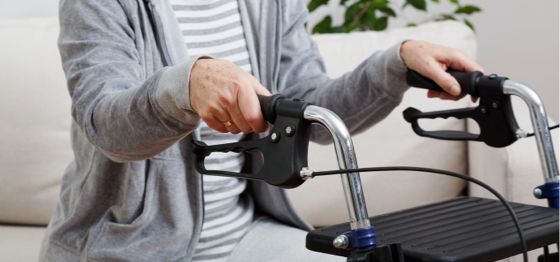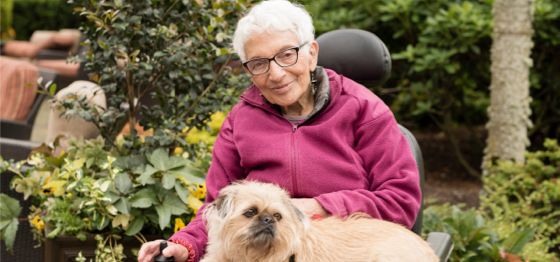As rewarding as providing care for an aging or ill family member may be, it may also be an exhausting and stressful activity. According to a report from the American Association of Retired Persons (AARP) Public Policy Institute and the National Alliance for Caregiving, more than a third of people who act as family caregivers rate their job as emotionally draining, while nearly 20% find it physically challenging as well.1
Too much time spent on this extremely demanding responsibility without a break may lead to depression, health problems and burnout.2 All caregivers may find it helpful to have someone who can tend to their loved ones for a few hours, days or weeks so they can care for themselves. That’s where respite care comes in.
Very simply, respite care helps provide a break for live-in caregivers. It may come from a variety of sources—family members, friends, faith-based organizations, volunteers, local, state and federal agencies or paid respite workers—and may happen in the home or at a facility like an adult day care center.
Types of respite care for the elderly
The many sources of respite care listed above fall mainly into these 2 categories:
- In-home respite care
This is often a popular choice since it allows the elderly to stay in their own homes while receiving care. Lasting from a few hours to overnight, this type of respite care may be arranged directly or through an agency and is provided by various types of caregivers, including:
- Volunteers available through faith-based, non-profit or other community organizations.
- Trained staff from home-care businesses; these professionals are adept at providing short- or long-term periods of care.
- Personal care providers who may assist with daily living skills like eating, bathing and dressing.
- Homemaker services that offer help with housekeeping, meal preparation and shopping.
- Skilled health caregivers with specialized training and expertise who can address the medical needs of the patient.
- Volunteers available through faith-based, non-profit or other community organizations.
- Out-of-home respite care
Depending on geographic location and the type of respite care required, a range of private and nonprofit programs may be available.
- Adult daycare centers, designed for seniors who are no longer independent, operate during daytime hours, usually Monday through Friday. Safe, supportive activities, along with meals and snacks, are part of most adult daycare programs.
- Residential programs provided by group homes, hospitals, nursing homes and other specialized facilities offer temporary care for shorter or extended lengths of time. Many may provide emergency and overnight services, giving caregivers a much-needed break for 24 hours or longer.
- Respite camps and caregiver retreats may be available in certain areas, providing opportunities for rest and relaxation, along with educational programs and peer group support.
- Adult daycare centers, designed for seniors who are no longer independent, operate during daytime hours, usually Monday through Friday. Safe, supportive activities, along with meals and snacks, are part of most adult daycare programs.
Overcoming obstacles to respite care
While respite care may be beneficial to both the caregiver and the person being cared for, less than 15% of family caregivers take advantage of it, even though nearly 40% of them believe respite care would help.3 The reason may be that common obstacles often stand in the caregiver’s way. They may include:
- The feeling that the daily caregiving routine is too complex to trust to an outsider.
- Guilt that results from thinking that it’s wrong to grow tired of caring for a loved one.
- The double-edged sword—a fear that the respite care provider may not do as good a job—or may do a better job of providing care.
These obstacles may be overcome by simply keeping in mind that respite care is an extremely important component of the entire continuum of care, not just for the older adult, but for the caregiver and the entire family as well.
Respite care costs
Many factors determine the cost of respite care including the type of care chosen, scope of insurance coverage and geographic location. In 2022, according to the National Institute on Aging, in-home care and assisted living both cost an average of around $150 per day, while adult day services cost an average of $78 a day.4
Though most insurance plans won’t cover the cost of respite care, there are several resources a caregiver may explore for assistance, including Medicaid, Veterans Benefits and long-term care insurance.5 Also, Medicare will cover the majority of the cost for up to 5 days in a row of respite care in a hospital or skilled nursing facility for someone receiving hospice care.6
Finding respite care services
Paid and volunteer respite care services may be found via numerous local, regional and national organizations that offer contacts and helpful information. Those searching for respite care may wish to start with the National Association of Area Agencies on Aging for a listing of local entities that connect caregivers with hourly in-home respite care, adult day care, overnight respite providers and more. The association may also provide information about no- or low-cost respite programs in the caregiver’s local area and whether financial assistance is available.
Questions to ask when choosing respite care
When considering choices among the 2 main categories of respite care, the caregiver may wish to ask specific questions like these as part of the process:7
For in-home respite care
- How long have you been providing in-home care?
- Are you cardiopulmonary resuscitation (CPR)-certified?
- Do you have additional training in healthcare?
- How do you handle emergencies?
For out-of-home respite care
- What type of training has the staff completed?
- Are there nurses or other medical professionals on staff?
- What safety procedures are in place?
- What daily activities are offered?
Go365 by Humana® makes wellness fun and easy. We help Humana Medicare members with Go365® on their plan reach health goals, as well as take care of their physical and emotional health—allowing members to thrive at any age.
Humana Medicare members with Go365 on their plan can enroll in Go365 at
Go365 is a well-being and rewards program for many Humana Medicare Advantage members. Rewards have no cash value and can only be redeemed in the Go365 Mall. Rewards must be earned and redeemed within the same plan year. Any rewards not redeemed by December 31st will be forfeited.
If you need to enroll in Medicare Advantage or change your plan outside of the usual Medicare Annual Election Period, a Special Election Period (SEP) could be the answer. For information on eligibility, visit Humana’s
To learn more about Humana Medicare Advantage, call to speak with a licensed Humana sales agent at 1-844-321-5843 (TTY:711), Monday – Friday, 8 a.m. – 8 p.m. local time or visit
Sources:
1“Respite Care: Create a Plan to Give Yourself a Caregiving Break,” AARP, last accessed June 13, 2023,
2“Respite Care: Create a Plan to Give Yourself a Caregiving Break.”
3“Respite Care: Create a Plan to Give Yourself a Caregiving Break.”
4“Understanding Respite Care,” HealthLine, last accessed June 13, 2023,
5“Understanding Respite Care.”
6“What is Respite Care,” National Institute on Aging, last accessed June 13, 2023,
7“Understanding Respite Care.”
This information is provided for educational purposes only. It is not to be used for medical advice, diagnosis or treatment. Consult your healthcare provider if you have questions or concerns.
Humana is a Medicare Advantage HMO, PPO and PFFS organization with a Medicare contract. Humana is also a Coordinated Care plan with a Medicare contract and a contract with the state Medicaid program. Enrollment in any Humana plan depends on contract renewal.






